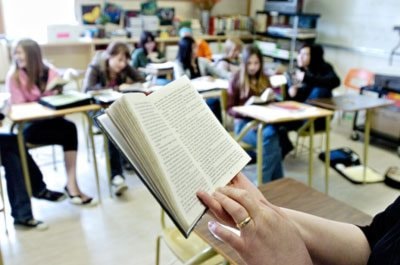Yukon’s Education Department misleads the public about the territory’s lacklustre graduation rates, says Canada’s auditor general.
The territory’s five-year average graduation rate is 63 per cent, well below the national average of 75 per cent.
The graduation rate for Yukon First Nation people is far worse, at about 40 per cent. Other students average about 65 per cent.
These are the department’s numbers. But it never published them.
Instead, it showed the public a different set of numbers in its annual reports. These figures inflate Yukon’s graduation rate by excluding all students who dropped out before entering Grade 12.
This allowed the department to report a graduation rate of 89 per cent—24 percentage points above the actual figure—for 2008.
This is “misleading,” said auditor general Sheila Fraser.
Why would Yukon’s actual graduation rate be suppressed by the government?
Maybe because it’s embarrassing.
The real graduation rate reveals a smaller percentage of Yukon children graduate than their peers in any province. Yukon does beat both other territories, but that’s a pretty small consolation prize.
The department’s last annual report admits other jurisdictions use different methods to calculate their graduation rates.
“The Department of Education will continue to work toward identifying the most informative way to represent graduation rates for future years,” the report states.
The annual report also claims there isn’t enough information to calculate the graduation rate of First Nation students. The audit shows this isn’t true.
Such information should be used to help close the gap in academic performance between aboriginals and other students, the audit states. Instead, the department appears to have pretended the information didn’t exist.
While Yukon offers several laudable programs to help students at risk of dropping out, it doesn’t measure the success of these programs in any meaningful way, so it’s impossible to know whether public money is being spent well or if students are being helped as much as they could be.
This is just one of many embarrassments found in the latest audit of the territory, which probed the department’s ability to effectively educate Yukon children.
It found many shortcomings.
“The Yukon Department of Education could not demonstrate to us that it effectively delivers public school programs to Yukon children,” the audit states.
Education Minister Patrick Rouble should resign, said Liberal Education critic Eric Fairclough, citing the report.
“It is clear from the report that the minister is not doing his job,” said Fairclough in a release.
“Having an outside audit done is always a healthy process as it allows for a different perspective,” said Rouble in a release. Department staff will discuss the report with the Public Accounts Committee this week, he added.
The committee meets on Friday at 10 a.m.
The audit may be healthy, but it’s not flattering.
It found the department lacked plans for almost everything, from staffing levels to enrolment trends and facility upgrades.
Take staffing. Across the Yukon, the department has hired more teachers even while student enrolment shrinks.
Student enrolment has declined by eight per cent over the past five years, but the number of teachers has grown by four per cent and other teaching staff has increased 14 per cent.
As a result, many schools are operating well below capacity. The most dramatic shift has occurred in Whitehorse schools, where there are nearly as many empty seats as enrolled students.
In 2008, 11 of 14 schools in Whitehorse operated below capacity, resulting in 3,200 empty seats. Actual enrolment in Whitehorse schools for 2007-08 was 3,879.
Many rural schools also operate well below capacity.
As a result, Yukon has the lowest student-educator ratio in Canada, with a five-year average of 11.7 to one. By comparison, the national five-year average is 15.5 to one.
Why is this a bad thing? After all, teachers and parents alike are always pushing for smaller classrooms.
But it’s a problem because the staffing increase is not guided by deliberate policy, said Fraser.
It just appears to be aimlessly drifting upward.
So planning would be useful, especially as Yukon enrolment is expected to drop further over the next five years, or perhaps longer.
But the department has no plan to manage this decline in students, said Fraser. There’s no comprehensive human resources plan. Nor is there a staffing-needs profile.
Such plans would help the department figure out the resources it needs to serve students, and how to best allocate them.
Meanwhile, many aging schools are approaching the end of their useful lives. Seven Yukon schools have lifespans of less than four years. Four other schools have lifespans of less than nine years.
Again, there’s clearly a need for some planning. But the department’s last long-term facilities plan expired a decade ago.
Plans for individual schools exist, but the department only reviews them occasionally. In 2007-08, it reviewed none. In 2006-07, it reviewed only eight of 28 plans.
An earthquake plan might be smart, too, as Yukon is prone to seismic activity.
BC is spending .5 billion over 15 years to make its schools earthquake-safe. But in Yukon, the auditor could find no evidence of any seismic evaluations of schools to respond to changes to the national building code in 2005.
Nor is there much co-ordination between the department and Yukon College to improve the number of Yukoners who enrol in post-secondary education. Yet such efforts will be needed to meet the territory’s shortage in skilled labour with local workers, rather than Outside contractors.
Contact John Thompson at
johnt@yukon-news.com.
